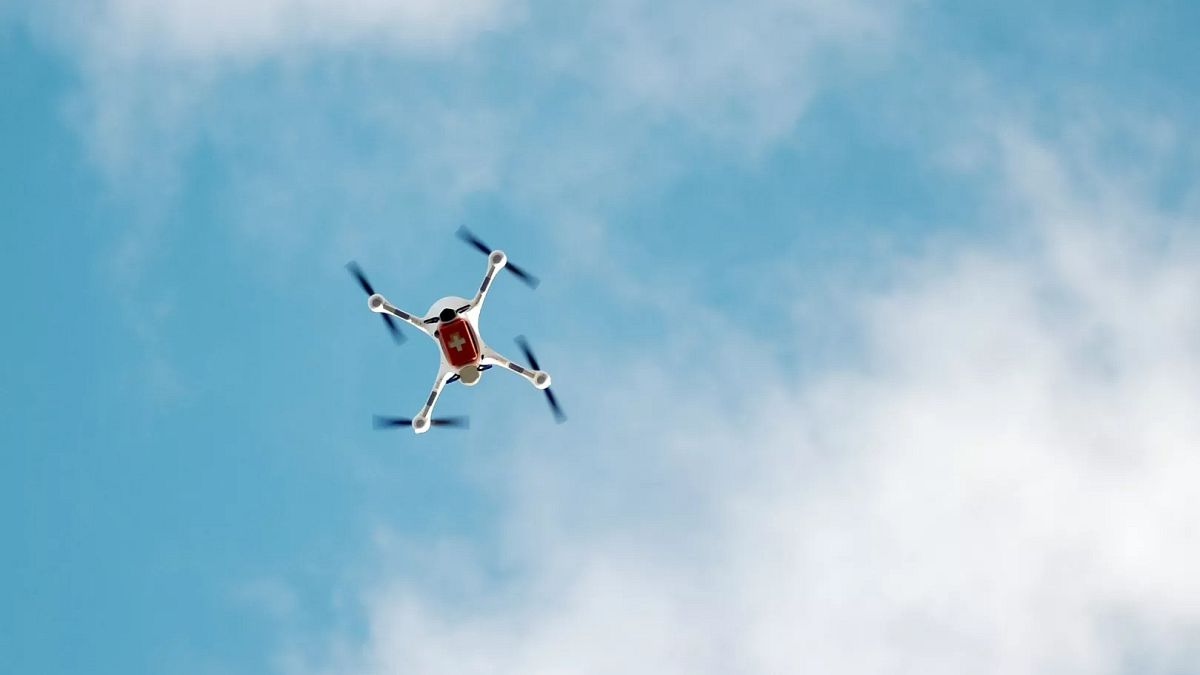Drone sightings in Germany earlier this month brought Munich Airport to a standstill, leading politicians to announce new measures against unidentified aerial vehicles.
On Wednesday, Interior Minister Alexander Dobrindt said that the country’s cabinet had approved a reform which would include the creation of a dedicated drone defence unit within the federal police.
The police will now be authorised to shoot down unmanned aircraft if necessary.
However, not all drones are dangerous, with many used for civilian purposes, particularly in logistics and healthcare.
In these sectors, supplies such as medicine, vaccines and blood samples are transported from one hospital to another, or to a laboratory.
Speaking to Euronews, Norman Koerschulte, founder of Morpheus Logistik, Germany’s only drone logistics company, explained that their drones have partly replaced conventional road transport.
“Where we fly, there’s no longer an alternative,” he said, citing a lack of taxi capacity, traffic congestion and heavy strain on infrastructure as reasons for the lack of other transport options.
Koerschulte said the advantage of drones is that they can cover the distance between hospitals and laboratories “super quickly” and can easily bypass traffic.
Around 250 laboratory samples are transported per flight, according to the drone company founder.
The rise in drone usage for civilian purposes is illustrated by the example of the Asklepios hospital group, which increasingly relies on drones to transport medical samples between its sites, according to German public broadcaster NDR.
Since March, drones have been regularly flying the 50 kilometre distance between Selent in the district of Plön and Bad Oldesloe in Schleswig-Holstein in northern Germany.
So far, they have completed around 100 transport missions and several hundred test flights. The aim is to ease pressure on road traffic and enable faster, more climate-friendly transport of blood and laboratory samples.
Can civilian and ‘hostile’ drones coexist in the same airspace?
Just like on the roads, clear rules are needed in the skies as well.
In Germany, drones weighing more than 250 grams, professional drones or those flying in sensitive areas must carry a “digital licence plate” known as an EID.
Only authorities and authorised bodies can access the EID, as transmitting position data could be misused to create movement profiles of drone operators.
Failure to display an EID can be treated as an administrative offence, punishable by fines of up to €50,000. In severe cases such as endangering air traffic, prison sentences ranging from six months to 10 years are possible.
Mini-drones used purely for recreational purposes are generally exempt from the EID requirement. It remains unclear what kind of drones were involved in the recent sightings, as none have yet been recovered.
In addition, drones can be monitored and controlled through the internal fleet management system FLAN.
Some also transmit their position data via ADS-B, a standard used in aviation that can, in theory, be received by anyone with the right equipment. However, linking a specific drone to its operator is only possible through official registration data.
Transparency in lower airspace
“We need a national initiative and clear visibility for the lower airspace,” Koerschulte, the founder of Morpheus Logistik, told Euronews.
Extending from the ground up to around 7.5 kilometres, this is the area in which most conventional aircraft, helicopters and drones operate.
Morpheus Logistik is calling for the full identification of all drones within this altitude range.
Koerschulte hopes it will be “as transparent as Flightradar24,” referring to the platform that allows users to track and identify manned aircraft in real time.
“We would need to introduce this identification requirement nationwide and eventually across the EU,” Koerschulte said.
Such a system would make it possible to quickly identify drones that might be used for espionage or sabotage.
“That would create a great deal of transparency and ultimately help ease people’s fears,” Koerschulte said, noting that every technology “can unfortunately be used for both ‘good’ and ‘bad’ purposes.”
He considers shooting drones down, as recently suggested by Bavarian Minister-President Markus Söder (CSU), to be an inefficient solution, partly because there are so many active drone pilots in Germany.
If every drone sighting were to be reported to the police or other authorities, Koerschulte believes it would only lead to confusion and uncertainty.
Instead, a system that allows the origin and type of drone to be identified would bring much-needed clarity to the skies, he argued.

